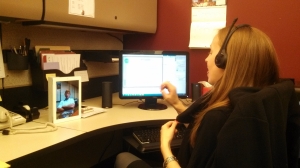Innovations in technology and the vital role of skilled professionals
In May 2014, BRITE and Nated Scotland curated an international conference hosted at Edinburgh University, where 100 delegates came together to evaluate a range of cutting edge strategies to support d/Deaf students at college and university. Two key themes of the day were the potential of mobile and web-based technology to revolutionise the provision of communication services, and the vital importance of skilled professionals to manage and deliver support for students.
 The image shows a sign language interpreter at the University of Cincinnati communicate with a student. The student accesses live video of the interpreter on his iPad. He could be based elsewhere on campus, or even off-campus e.g. having an informal study session at a classmate’s home. This system provides students with a new level of flexibility in how they access communication services. Research into the implications of this mode of service delivery was the subject of our keynote presentation.
The image shows a sign language interpreter at the University of Cincinnati communicate with a student. The student accesses live video of the interpreter on his iPad. He could be based elsewhere on campus, or even off-campus e.g. having an informal study session at a classmate’s home. This system provides students with a new level of flexibility in how they access communication services. Research into the implications of this mode of service delivery was the subject of our keynote presentation.
A summary of the presentations and key topics follows. To request a copy of the conference brochure, transcripts of the presentations, or copies of slides, please contact Kellie Mote at kmote@brite.ac.uk.

